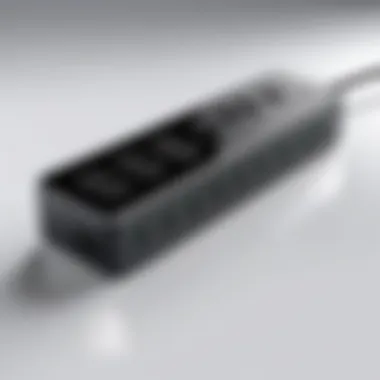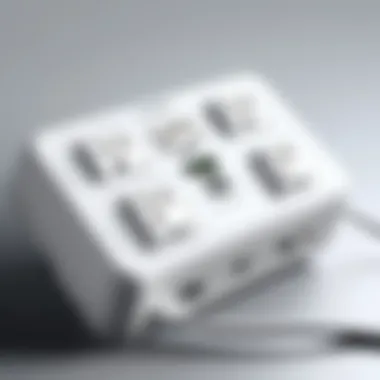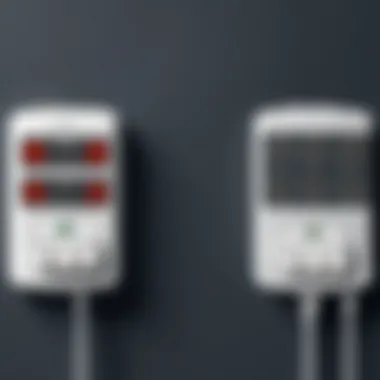Choosing Surge Protectors with USB Ports: A Guide


Intro
In today's digital age, the many electronic devices we rely on are as common as the air we breathe. From laptops to smartphones, the electrical currents that power our gadgets can be a double-edged sword. This is where surge protectors come into play, particularly those equipped with USB ports. These handy devices not only shield against voltage spikes but also offer the convenience of charging multiple devices simultaneously.
Having the right surge protector is vital, as a power surge can lead to significant damage, which could mean a hefty repair bill or, worse, the loss of important data. Therefore, understanding the features of surge protectors with USB ports can greatly enhance both the safety and the efficiency of your electronic setup.
As we navigate this guide, we'll delve into the technical specifications, practical applications, and recent trends surrounding surge protectors with USB ports, ultimately assisting you in choosing the one that aligns with your unique needs.
Understanding Surge Protection
In a world where electronic devices have become as common as air, understanding surge protection isn't just a good idea; it's essential. With our lives intertwined with gadgets—from smartphones to gaming consoles—ensuring their safety against electrical surges is key. A surge protector acts as a first line of defense, safeguarding your cherished electronics. These devices are not only about convenience; they play a critical role in preserving the longevity and functionality of your tech.
What is a Surge Protector?
A surge protector is a device that helps shield electrical devices from sudden spikes in voltage. These spikes can occur due to various reasons, like lightning strikes or power outages. Essentially, a surge protector diverts excess voltage away from your equipment, preventing potential damage.
Imagine having a vintage video game console or a high-tech home theatre system. Without an adequate surge protector, a simple electrical hiccup can render your valuable devices useless. In other words, a surge protector is akin to a sturdy umbrella in a storm—it keeps your sensitive electronics safe and sound.
Why Surge Protection is Necessary
The necessity of surge protection becomes evident in understanding the risks posed by electrical surges. Unpredictable surges can fry circuit boards, melt components, and create a host of issues that might not be immediately noticeable. In the long run, the absence of such protection might lead to costly replacements or repairs. Here are a few compelling reasons to consider:
- Financial Savings: Prevents costly damage to electronics, potentially saving hundreds or thousands of dollars in replacements.
- Safety: Reduces the risk of fires caused by electrical faults.
- Longevity: Enhances the lifespan of your devices, ensuring they deliver peak performance for years.
Addressing surge protection ultimately means protecting your investments—both financially and practically.
How Surge Protectors Function
Surge protectors work by utilizing several components to intercept excessive voltages before they reach your devices. The most common protective technology is metal oxide varistors (MOVs), which absorb excess voltage and then route it to the ground. Think of them as the safety nets for your electrical devices. Here’s a simple breakdown of their functionality:
- Voltage Sensing: As soon as the incoming voltage exceeds a certain threshold, the surge protector detects the surge.
- Voltage Diversion: The excess voltage is redirected away from connected devices to the ground.
- Normal Operation: Once the surge passes, the surge protector allows the regular voltage to continue flowing to your devices.
Surge protectors are deceptively simple yet highly effective. It's crucial to choose one with a high joules rating to ensure adequate protection for everything from office equipment to gaming gear. So, the next time you plug in your high-end computer setup, remember, the surge protector is your unsung hero, quietly working in the background to fend off the threats of electrical surges.
The Role of USB Ports in Surge Protectors
The integration of USB ports into surge protectors has become more than just a handy feature. It acts like a bridge between providing surge protection and the increasing demand for charging multiple electronic devices simultaneously. In a world where charging cables have multiplied and cluttered our lives, having USB ports built into surge protectors is a game changer, simplifying our charging needs while keeping our devices protected.
Convenience of USB Ports
What makes having USB ports on surge protectors so appealing is the convenience they bring to everyday life. Instead of hunting for a wall outlet or a separate charger, multiple devices can be plugged directly into one device. For instance, one can charge a smartphone while still having room for a laptop and even an extra smartwatch; it’s like having your cake and eating it too.
Imagine a night stand cluttered with charging cables – wouldn’t it be nice to just reach for one surge protector? The convenience doesn't stop there. USB ports usually offer quick access to power without the need to find a bulky adapter, making them user-friendly for both tech-savvy individuals and everyday users alike.
The simplicity of just plugging in a device and hitting the switch really can’t be overstated.
Charging Multiple Devices
Another notable aspect of USB ports in surge protectors is their capacity to charge multiple devices at once. Many of today’s models come with several USB ports, allowing users to power everything from smartphones and tablets, to gaming devices, all in one go. This feature is especially practical for gamers or busy professionals who often have multiple devices that need power.
- Time-Saving: Not having to recharge devices one after the other reduces downtime, keeping users connected.
- Efficient Power Distribution: Quality surge protectors with USB ports can manage the required power efficiently. This means that devices can be charged quickly, without overloading the circuit, making it safe and reliable.
In a household with multiple users, having this capability means less squabbling over the single wall outlet. Everyone can charge their devices at once without stepping on each other’s toes.


Compatibility with Various Devices
Not all devices are created equal. Some require specific voltage or amperage to charge effectively. Thankfully, surge protectors with USB ports typically offer compatibility with a wide range of devices. This includes smartphones, tablets, and even some laptops. By incorporating universal USB ports, these surge protectors remove the hassle of managing different chargers for different devices, making life that much easier.
Additionally, some surge protectors now offer Smart USB ports that automatically detect the required charge for a specific device. This ensures that your precious tech gets just the right amount of power, helping to prolong battery lifespan. This versatility in charging options also means that older devices can benefit, too, ensuring that even outdated tech can still find a place to charge.
Ultimately, finding a surge protector with USB ports not only adds convenience and efficiency but aligns with the modern-day user’s lifestyle that inherently revolves around multiple devices.
Key Features to Consider
Considering a surge protector with USB ports goes beyond just picking a model. It's about understanding what features genuinely elevate the device’s performance and ensure undeniable protection for your valuable electronics. Each feature contributes to the overall reliability, usability, and longevity of the surge protector, making it essential to know what to look for when scanning through options in the marketplace.
Joules Rating Explained
One of the first numbers to pay attention to is the joules rating. This is a key indicator of how much energy the surge protector can absorb before it fails. In simple terms, a higher joules rating usually means better protection.
- For basic household equipment, a rating of around 500 joules might get the job done. But, if you have high-end devices, especially PCs or gaming systems, look for at least 1000 joules or more.
- Just like a sponge, the joules rating tells you how much "water" (in this case, power surges) it can handle. If you want devices to last longer, don’t skimp here; choose a model with an adequate joules rating that fits your needs.
Number of Outlets
Having multiple outlets can be a game changer, especially in today's world where devices seem to multiply overnight. Think about your setup: perhaps you have a computer, a smartphone, a tablet, and maybe a gaming console. You wouldn’t want a situation where you’re juggling your devices due to limited outlets.
- Surge protectors can vary from having 3 outlets to as many as 12. Assess your fundamental needs, and don’t forget to include the USB ports in your gadget tally. Many modern surge protectors combine AC outlets with USB ports, often making them better suited for charging multiple devices simultaneously.
- Tip: Always go for a bit more than you think you'll need. That way, you avoid having to replace it down the line when you want to add something new.
USB Power Output
The power output for USB ports is just as important as the surge protector's overall performance. USB ports can have various power outputs, often measured in amps. Understanding this can ensure that your devices charge efficiently without hogging unnecessary power.
- Most standard USB ports provide 5V at 1A, sufficient for smartphones and tablets. However, for fast charging, look for ports rated at 2.4A or more.
- Also, keep your device's charging requirements in mind. If you have gadgets that require more power, ensure the surge protector supports adequate output for those devices to avoid sluggish charging.
Response Time
Aside from the joules rating, the response time of a surge protector is essential for effective protection. This is the time it takes for the protector to react to a surge and cut off power, minimizing exposure to damaging electrical currents.
- A response time of less than 1 nanosecond is ideal; it indicates a quick system designed to effectively protect your electronics. Slower response times could leave your devices vulnerable to significant damage during a surge, which can occur in just a fraction of a second. Keep this aspect at the forefront when making your decision.
Build Quality and Design
Lastly, the construction and overall design of a surge protector shouldn't be brushed aside. Many consumers fall into the trap of focusing solely on features while overlooking the tangibles like durability and design aesthetics.
- A sturdy build means better longevity, especially if you're dealing with heavy cords and multiple devices. Look for materials that can withstand wear and tear, preventing breakdowns over time. Also, consider how the design fits into your home or office layout.
- Additionally, check about safety features such as automatic shut-off and built-in circuit breakers. These features act like a safety net, ensuring that when something goes awry, you and your devices remain protected.
Top Surge Protectors with USB Ports
Choosing the right surge protector, especially one with USB ports, can feel like trying to find a needle in a haystack amidst a plethora of options. With gadgets emerging at lightning speed, protecting your devices is no longer just an option; it’s a necessity. Surge protectors equipped with USB ports simplify life. They're great for household, office, or even for gamers who want to manage multiple devices without the tangled mess of cords.
Investing in a good surge protector can save you from the headache of replacing your electronics. That’s the kind of peace of mind everyone craves. And let’s be real, the convenience of USB ports means you can charge your phone, tablet, or other USB-powered devices right from the same protector that safeguards your expensive electronics.
But not all surge protectors are cut from the same cloth. Some are more robust, while others might skimp on the essentials. It’s about knowing which model brings the right blend of features and reliability that fits your unique needs.
Model A: Overview and Specifications
Model A stands out in a crowded field thanks to its high joule rating of 2000, which means it can absorb significant power surges. It offers four AC outlets and two USB ports, allowing for a mix of devices to be connected seamlessly. This model's compact design ensures it doesn’t dominate your desk real estate, and the indicator light provides a clear visual cue that it’s actively protecting your electronics.
Key Specs:


- Joules Rating: 2000
- Outlets: 4 AC, 2 USB ports
- Design: Compact with indicator light
- Warranty: Lifetime warranty with connected equipment coverage up to $50,000
Model B: Overview and Specifications
Next on the list is Model B. Recognized for its smart charging technology, this unit can optimize power delivery to connected devices. It boasts a joule rating of 1500, making it suitable for moderate protection requirements. The additional feature of a power switch allows users to easily cut off power when necessary, which can help save energy.
Key Specs:
- Joules Rating: 1500
- Outlets: 6 AC, 4 USB ports
- Special Features: Smart charging, power switch
- Warranty: 1-year limited warranty
Model C: Overview and Specifications
Model C is often lauded for its versatility. With a joules rating of 2500, it provides top-tier protection for those with more demanding setups, particularly useful for gaming or home offices. This model includes not just regular AC outlets but also a rotating AC plug, allowing for more flexibility in tight spaces. Plus, it comes with a built-in surge protection for coaxial cables, offering multi-layered defense against surges.
Key Specs:
- Joules Rating: 2500
- Outlets: 8 AC, 2 USB ports
- Special Features: Rotating AC plug, coaxial protection
- Warranty: Lifetime warranty with $75,000 connected equipment guarantee
Model D: Overview and Specifications
Finally, Model D brings ingenuity into the mix with a unique design that allows it to be mounted on the wall. Its joules rating is at 1800, sufficient for most home and office applications. The inclusion of a child safety cover on the AC outlets makes this model family-friendly, offering peace of mind if you have little ones around. This features strikes a balance between functionality and safety.
Key Specs:
- Joules Rating: 1800
- Outlets: 4 AC, 3 USB ports
- Design: Wall-mountable with child safety covers
- Warranty: 2-year limited warranty
These models are not just products, they’re guardians of your tech kingdom, preserving your devices from the unpredictable whims of electrical surges. A well-selected surge protector with USB ports is the unsung hero in your digital life.
Comparative Analysis of Features
When diving into the world of surge protectors, particularly those adorned with USB ports, a detailed comparative analysis becomes paramount. This segment addresses the importance of evaluating features that can significantly influence your device management strategy. Understanding such features helps consumers tailor their purchasing decisions to fit their specific needs.
Surge protection is crucial, but with the plethora of options available on the market, it can feel like trying to find a needle in a haystack. A proper comparative analysis not only simplifies this decision-making process but also highlights aspects you may otherwise overlook.
Side-by-Side Feature Comparison
A feature comparison allows for a clear visualization of how each model stacks up against the competition. When assessing surge protectors with USB ports, consider examining the following elements:
- Joules rating: This indicates the device's capacity to absorb energy. Higher joules mean better protection. For instance, a model rated at 3000 joules is significantly superior in guarding your electronics compared to one with a rating of 800 joules.
- Number of outlets: Think about your charging needs. If you have multiple devices, choose a model that offers ample outlets. Some models even include additional USB ports for more convenient charging.
- Power output for USB ports: Not all USB ports are created equal. Check the output specifications; a higher amperage indicates faster charging times. You want the one that offers 2.4A or more for optimal performance.
- Design and build quality: Not just about looks, the sturdiness and design of the surge protector will affect its longevity. Inspect the material and build, as a well-constructed surge protector can withstand daily wear and tear.
Here's a snapshot for better clarity:
| Model | Joules Rating | USB Ports | Amperage | Number of Outlets | Build Quality | | Model A| 3000 | 4 | 2.4A | 6 | High | | Model B| 1500 | 2 | 1.5A | 4 | Medium | | Model C| 2500 | 3 | 2.1A | 5 | High |
Pros and Cons of Each Model
With a clearer picture of features, it’s helpful to weigh the pros and cons of specific models. This can aid in discerning which product aligns best with your needs:
- Model A
Pros: High joules rating, multiple USB ports, reliable build quality.
Cons: A bit pricier than others in its class. - Model B
Pros: Budget-friendly, compact design.
Cons: Lower joules rating and fewer ports may limit usage. - Model C
Pros: Good balance of features, decent performance.
Cons: Not the most compact option; takes up a bit more space.
Utilizing a side-by-side comparison alongside a pros and cons analysis empowers you to select the surge protector that best fits your lifestyle, ensuring your devices remain safe from unexpected surges.
Installation and Usage Guidelines
When it comes to safeguarding your electronic devices with surge protectors that feature USB ports, installation and usage guidelines play a pivotal role. Proper installation not only ensures that your devices are effectively protected from voltage spikes but also maximizes the efficiency of the surge protector. Neglecting these aspects can lead to suboptimal performance and even damage to your devices.


To get the most out of your surge protector, understanding how to install and deploy it correctly is essential. This includes knowing where to place it, how to connect it, and the best practices for daily use. By following these guidelines, you can provide a robust defense against potential electrical issues, ensuring that your devices remain running smoothly.
How to Properly Install a Surge Protector
Installing a surge protector may seem straightforward, but a few steps can ensure you're setting it up for optimal protection.
- Choose the Right Location
- Inspect for Damage
- Plug It In Securely
- Connect Devices Wisely
- Test Your Setup
- Place the surge protector in a dry area, avoiding spots where moisture can seep in.
- Ensure it's close to power sources and the devices you intend to protect.
- Before installation, check the surge protector for any visible defects. A cracked casing can be a red flag.
- When connecting the surge protector, make sure it fits snugly into the outlet. A loose connection can lead to malfunction.
- Avoid plugging in high-energy devices like refrigerators or air conditioners, as they can overwhelm the unit. Instead, reserve the ports for sensitive electronics like computers, gaming consoles, and phones.
- Once everything is connected, if your protector has an indicator light, ensure it's lit. This confirms the unit is functioning correctly.
Proper installation can significantly enhance the lifespan and efficiency of your surge protector.
Best Practices for Usage
After installation, following best practices for usage is imperative to maintain the effectiveness of your surge protector with USB ports.
- Regularly Check Indicator Lights: Most surge protectors have an LED that signals operational status. If this light goes out, it indicates the need for replacement.
- Don’t Overload: Be mindful of the number of devices connected. An overloaded surge protector can become a fire hazard.
- Unplug Devices During Storms: For added protection, unplug your devices if severe weather is on the horizon. This is especially true for sensitive items like computers.
- Keep Your Surge Protector Clean: Dust accumulation can affect performance. Regularly wipe down the device to keep it functioning well.
- Keep an Eye on Lifespan: Be aware that surge protectors do wear out over time. It's advisable to replace them every 3 to 5 years, or sooner if the unit has absorbed significant surges.
By adhering to these installation and usage guidelines, you can significantly improve the longevity and efficiency of your surge protector, ensuring your devices are shielded from unexpected electrical disturbances.
Maintenance and Lifespan
Understanding the maintenance and lifespan of surge protectors, especially those equipped with USB ports, is crucial for ensuring optimal performance and safeguarding your devices. These protection devices act as the first line of defense against voltage spikes, but like all electronic equipment, they require proper care to function effectively over time.
Checking the Condition of Your Surge Protector
Regularly checking the condition of your surge protector can make a significant difference in its effectiveness. Here are some points to bear in mind:
- Visual Inspection: Look for any signs of wear and tear. Cracked casings, exposed wires, or any discolored areas may indicate potential failure.
- Indicator Lights: Many surge protectors have indicator lights that show when they are functioning correctly. If the light is off, your protector might be nonoperational, suggesting it needs immediate attention.
- Test Button: Use the test button if your model has one. Pressing this button helps to confirm that your surge protector is still working as intended.
The aim of these checks is to catch issues early. If you notice anything unusual, replacing the unit might be prudent, to avoid risking your valuable electronics.
Lifespan Expectations
The lifespan of a surge protector doesn't follow a strict timeline; different factors can influence how long these devices last. Generally, a good surge protector offers protection for about three to five years. However, this can vary based on several elements:
- Usage Frequency: If you use your surge protector daily, it may wear out faster than one used occasionally.
- Joules Rating: The joules rating determines how much energy it can absorb before it fails. A higher joules rating means a longer lifespan when subjected to surges.
- Quality of the Unit: Investing in high-quality models like the Belkin SurgeMaster or Tripp Lite can yield better longevity compared to inexpensive, lesser-known brands.
"Regular maintenance can extend the life of your surge protector and ensure your devices remain safe for longer."
Epilogue
In the ever-evolving landscape of technology, safeguarding our electronic devices has grown increasingly important, and surge protectors with USB ports bridge the gap between functionality and convenience. This article has explored various facets of choosing the right surge protector, emphasizing their usage not just for traditional devices but also for our ever-present handheld gadgets.
Final Thoughts on Surge Protectors with USB Ports
When considering a surge protector, opting for one with USB ports can truly enhance your daily life. They offer several invaluable benefits:
- Convenience: No more hunting for multiple chargers or adapters. With USB ports integrated into the surge protector, you can charge your smartphone, tablets, and other gadgets all in one spot.
- Space-saving Design: These protectors often have a compact design that helps de-clutter your workspace or bedside table.
- Multifunctionality: Not only do they protect against power surges, but they also act as a charging hub for all your devices, which can be a game-changer for tech-savvy individuals.
- Variety of Models: From basic models to high-end versions with advanced features, there’s a surge protector out there to fit everyone’s specific needs and budget.
"Selecting the right surge protector can mean the difference between a dead device and a protected investment."
Consideration of factors including joules rating, number of outlets, and build quality is crucial. This careful selection can ensure longevity and reliability for your devices, whether they be for gaming, personal use, or work. With your knowledge now expanded, you’re in a better position to make an informed choice that tailors specifically to your lifestyle. Embrace the safety and convenience that come with choosing a surge protector that meets your demands.







